Relevant Overviews
Overview: AI, chatGPT, LLM
Relevant resources

Juice the creative output of old knowledge workers with a wide range of AI-created ideas. Then leverage their superior crystallized intelligence and human judgment for wise winnowing, narrowing these options to select the best solution. Finally, remix with human insight for true human-computer symbiant power.

AI video models advanced significantly in 2025, particularly in avatar expressiveness, enabling me to produce much better videos than in 2024. Further improvements are needed in 2026 to realize the potential of individual creators. Here are my 10 most popular videos, as determined by audience clicks and viewing durations.

Summary: Our study shows that generative AI is reshaping search, but long-standing habits persist. Many users still default to Google, giving Gemini a fighting chance.

The Problem: AI is destroying web economics. Google created a toxic incentive system. Traffic collapse is accelerating. Content creation incentives are disappearing. The Solution: Collective action to create scarcity. The Vision: A better future - quality over clickbait.

Usability goes beyond simplicity; it's a dialogue between design and user, built on subtlety, emotional insight, and cognitive understanding. True usability shines under pressure, ensuring users effortlessly achieve goals even amidst stress or distraction. At its core, usability quietly empowers users, turning complex technology into invisible, sea

Artificial intelligence has revolutionized everything from customer service to content creation, giving us tools like ChatGPT and Google Gemini, which can generate human-like text or images with remarkable accuracy. But there’s a growing problem on the horizon that could undermine all of AI’s achievements—a phenomenon known as "model collapse."

It’s easy to place too much trust in genAI tools. Use only information you can verify or recognize to be true.
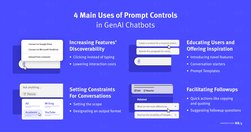
When following good practices, prompt controls can increase the discoverability of genAI chatbots’ features, offer inspiration, and minimize manual user input.

Do you feel that you don’t know enough about AI and what it will do to your industry? You are not alone. The Wall Street Journal reports that a survey of 10,000 workers and executives cited AI as a reason 71% of CEOs said they had “impostor syndrome.”
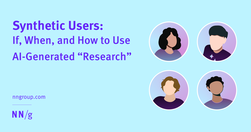
Synthetic users are fake users generated by AI. While there may be a few use cases for them, user research needs real users.
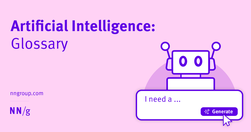
Use this glossary to quickly clarify key terms and concepts related to artificial intelligence.

As a designer, designing for trust in Artificial Intelligence (AI) products is paramount. AI presents unique challenges that require transparent interfaces, clear feedback, and ethical considerations to build user confidence.
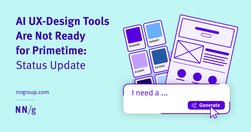
Our research and evaluation show that there are currently few design-specific AI tools that meaningfully enhance UX design workflows. As of Spring 2024, AI isn’t ready for designers to take advantage of them. AI tools won’t be replacing UX designers any time soon. Currently available LLM-based tools are not shortcutting steps in the design process
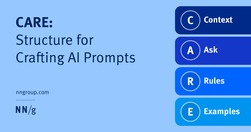
To get better results from generative-AI chatbots, write CAREful prompts. Include context, what you’re asking the system to do, rules for how to do it, and examples of what you want.
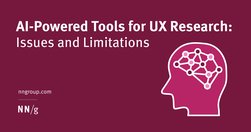
Be skeptical of the marketing claims being made by AI tools designed for UX researchers. Many of these systems are not able to do everything they claim.

With the proper context, prompts, and scrutiny, AI chatbots can be used to create a successful user-research plan.

Prompt engineering is the process of creating effective prompts for artificial intelligence (AI) systems. A prompt in AI is a specific instruction or input given to an AI system to elicit a desired response or output. Effective prompt engineering results in good communication between the user and the AI system, where the user guides the AI systems
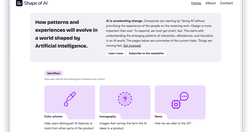
AI is accelerating change. Companies are reacting by “doing AI”without prioritizing the experience of the people on the receiving end–Design is more important than ever. To respond, we must get smart, fast. This starts with understanding the emerging patterns of interaction, affordances, and heuristics in an AI world. The pages below are summaries

The dual prompting approach in AI-driven UX design distinguishes between exploratory and detail-refining phases. Alternating these prompt styles can optimize your UX strategies and harness AI's potential for innovation and precision. Use both zero-shot and few-shot prompting for greater breadth and depth in creative problem-solving.

Will AI turn our brains to mush? History suggests otherwise. From writing to calculators to spell check, new tech has always sparked fears of cognitive decline. But AI, like previous innovations, will free our minds for deeper thinking. Embrace AI as a forklift for the mind. AI won't make us stupid — it’ll make us smarter.
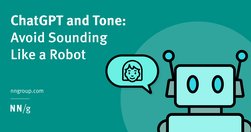
Many writers turn to ChatGPT or other AI chatbots to edit and perfect their tone. Much like people, however, AI struggles to convey nuanced emotions.

Traditional methods for accessibility have been tried for 30 years without substantially improving computer usability for disabled users. It’s time for a change, and AI will soon come to the rescue with the ability to generate a different user interface for every user, optimized for that person’s unique needs.

ChatGPT is a bullshit generator. To understand AI, we should think harder about bullshit

AI can already perform many UX tasks, ranging from design and research ideation to analyzing qualitative user data at scale. It’s the perfect assistant that quickly produces the first drafts of any UX method plan or deliverable. It will do more in the future,... possibly complete UI designs. But AI will not eliminate the need to watch human users.
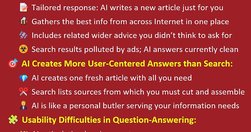
Content creators face reduced search traffic due to AI's prowess in delivering tailored answers, challenging traditional SEO strategies. Social will also drive less traffic. Permission marketing will be the main way to survive on the Internet.

To maximize the benefits to humanity, decisions to deploy AI solutions must be based on comparing AI with the average performance of unaided humans, not an unrealistic comparison with the single best human or with unachievable perfection.

In a case study of ChatGPT evaluating 12 e-commerce screenshots, most of the AI-driven redesign suggestions were inconsistent and untrustworthy. Human UX expertise must be employed to judge UX advice from AI.
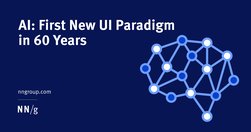
AI is introducing the third user-interface paradigm in computing history, shifting to a new interaction mechanism where users tell the computer what they want, not how to do it — thus reversing the locus of control.

Most prompts contain a combination of the following components: request, framing context, format specification, and one or more references to previous answers or external sources. There are also 3 types of unconventional prompts that do not follow this structure: "Can you do X," "Give me more," and filler prompts.
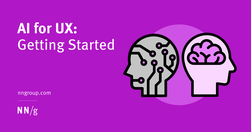
Use generative-AI tools to support and enhance your UX skills — not to replace them. Start with small UX tasks and watch out for hallucinations and bad advice. All UX professionals should use AI: it’s helpful at any level of seniority and for many tasks within the UX lifecycle (including research, design, and writing).